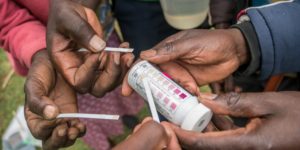
Montane forests in East Africa play a crucial role as water towers, holding freshwater long enough for it to recharge aquifers that supply local communities.
On the other hand, a recent project from the Center for International Forestry Research (CIFOR) in Kenya that forms part of the CGIAR Research Program on Forests, Trees and Agroforestry (FTA) has been examining what communities can do for the water towers.
“The state of forests in Kenya is really critical, so we wanted to estimate their water supply services to inform authorities and society of their value,” says Mariana Rufino, Senior Associate at CIFOR and Chair of Agricultural Systems at the UK’s Lancaster Environment Centre.
Read more: Bridging research and development to generate science and solutions
When she and fellow researchers found there were no consistent datasets on the state of water resources in the Sondu-Miriu River basin, a remote catchment in western Kenya, they decided to test an approach that is rarely used in developing countries, and even more uncommon in the field of hydrology: involving citizens in monitoring and crowdsourcing data collection.
“Collecting data for water flow and quality is expensive, so we set out to find low-cost alternatives to the sophisticated standard methods used elsewhere,” says Rufino.
The team installed 13 water-level gauges equipped with signs explaining the monitoring process, instructing passersby to send measurements via text message. They would then receive immediate feedback on their phones.
Over the course of one year, experts compared the crowdsourced data with that of automatic gauging stations installed nearby.
Watch: A technical overview: The role of citizen science in monitoring water towers in Kenya
In addition to overcoming data scarcity, the project sought to answer two key questions: first, if rural communities in a remote tropical setting would engage in citizen science; and if so, whether or not they would produce data of high enough quality to inform water resource management.
The scientists published a report on their findings, as well as producing two videos to show the benefits of citizen monitoring to local and national natural resource managers and land-use planners.
“We thought that showing our project locations and sharing the stories of people we collaborated with would also increase interest in the role of forests in the supply of water,” says Rufino.
Read more: FTA scientists feature in innovative series of talks on landscapes
PHONING IN
In the end, 124 citizens reported 1,175 valid measurements. Less than 5 percent of the data points was invalid.
“We were struck by the participation rate,” says coauthor of the paper Lutz Breuer, Chair of Landscape, Water and Biogeochemical Cycles at the Research Centre for Biosystems, Land Use and Nutrition at Justus Liebig University Giessen in Germany.
“The quality of the data was also excellent, with almost no difference against that of our sophisticated equipment,” says Rufino. “Communities were interested in the initiative, and they told us why: their livelihoods depend on water, so they want to know the state of the resource.”
Based on phone surveys on the socioeconomic background of volunteers, the study concludes: “The active participation is not depending on the actual education level, but rather induced by their personal perception of and dependency on their environment.”
“We are talking about open access data: data that belongs to the people, and that could be used by them to make decisions about resource use,” says Breuer.
“Monitoring the condition of a resource by its users is an important aspect of governance, as it is generally expected to be the basis for the design or adjustment of the use and management of the resource,” echoes CIFOR Principal Scientist Esther Mwangi.
Watch: Opinions and testimonials: The role of citizen science in monitoring water towers in Kenya
MEASURING UP
This is not to say that citizens can entirely replace scientists and authorities. Certain hydrological parameters are too complex for citizen management, and Rufino says the team is seeking to engage Kenya’s Water Resources Agency to help implement the project in two new sites.
And, there’s the issue of keeping people engaged over a long period of time.
To address this, the study paid back the transmission costs (1 US cent per text message) sent from one of the stations, twofold. This proved to increase participation rate, which there was between 2.5 and 7 times higher than at other stations.
However, Rufino believes that “true, sustained engagement will come when locals see value in the data collection and can do something with it.”
For example, if communities understand that a lack of vegetation leads to runoff and lower water tables, they may decide to increase tree cover. Likewise, if they see the links between logging and increased sediment in their drinking-water streams, they may take steps to manage the felling.
“A logical next step would be an assessment of whether and how such locally generated data can spur local actions aimed at sustainable resource management,” says Mwangi.
The scientists will also explore hydrological modeling approaches, both to fill gaps in irregular measurements taken by citizens and to model future alternatives for the region.
“By modeling the effect of land-uses on water fluxes, we can anticipate impacts on water supply, and advise people how to improve agricultural and forest management,” Breuer says.
For Rufino, the project proved that crowdsourcing is the way forward. “We are confident this data-collection model can disseminate in East Africa, and we will make ourselves available to discuss the implementation of this approach with water resource management agencies in the region.”
For low-income countries, the scientists agree that this low-cost approach can work.
By Gloria Pallares, originally published at CIFOR’s Forests News.
This research forms part of the CGIAR Research Program on Forests, Trees and Agroforestry, which is supported by CGIAR Fund Donors.
This research was supported by the German Research Foundation (DFG) and the German Corporation for International Cooperation.











